Net-Zero Energy Campuses in India: Blending Education and Governance for Sustainable and Just Transition
Abstract
1. Introduction
2. Existing Models and Framework
2.1. Net Zero at Universities
2.2. Knowledge Gap and Contributions
3. Proposed Model
- Digitization of everything, including infrastructure, information, resources, and processes, which are otherwise either unaccounted or accounted for in logbooks/registries;
- Democratization of information leading to actionable insights by relevant stakeholders in various capacities leading towards open innovation and energy citizenship;
- Decarbonization of the built environment.
3.1. Digitization
3.2. Interventions
3.3. Scenario Analysis
- Buildings and infrastructure: This includes hostels, faculty and staff housing, faculty and academic staff offices, administrative offices, dining cum-community kitchens, lecture theatres, network equipment, data centers, EV charging stations, renewables, energy storage facilities, and local energy distribution stations;
- Number of students: The students join the academic programs (UG, PG, and PhD) offered on-campus by different academic units;
- Number of faculty and staff: This includes faculty members, academic and administrative staff, and their respective families;
- Operations: This encapsulates factors that affect the energy consumption on campuses, including the schedule of hours of operation (day-long, evening college, remote classes, and fixed length of time per day), flexible workplace culture (work-from-home and fixed/flexible number of office days per week), and space ownership (co-working/dedicated/open-plan offices), among others.
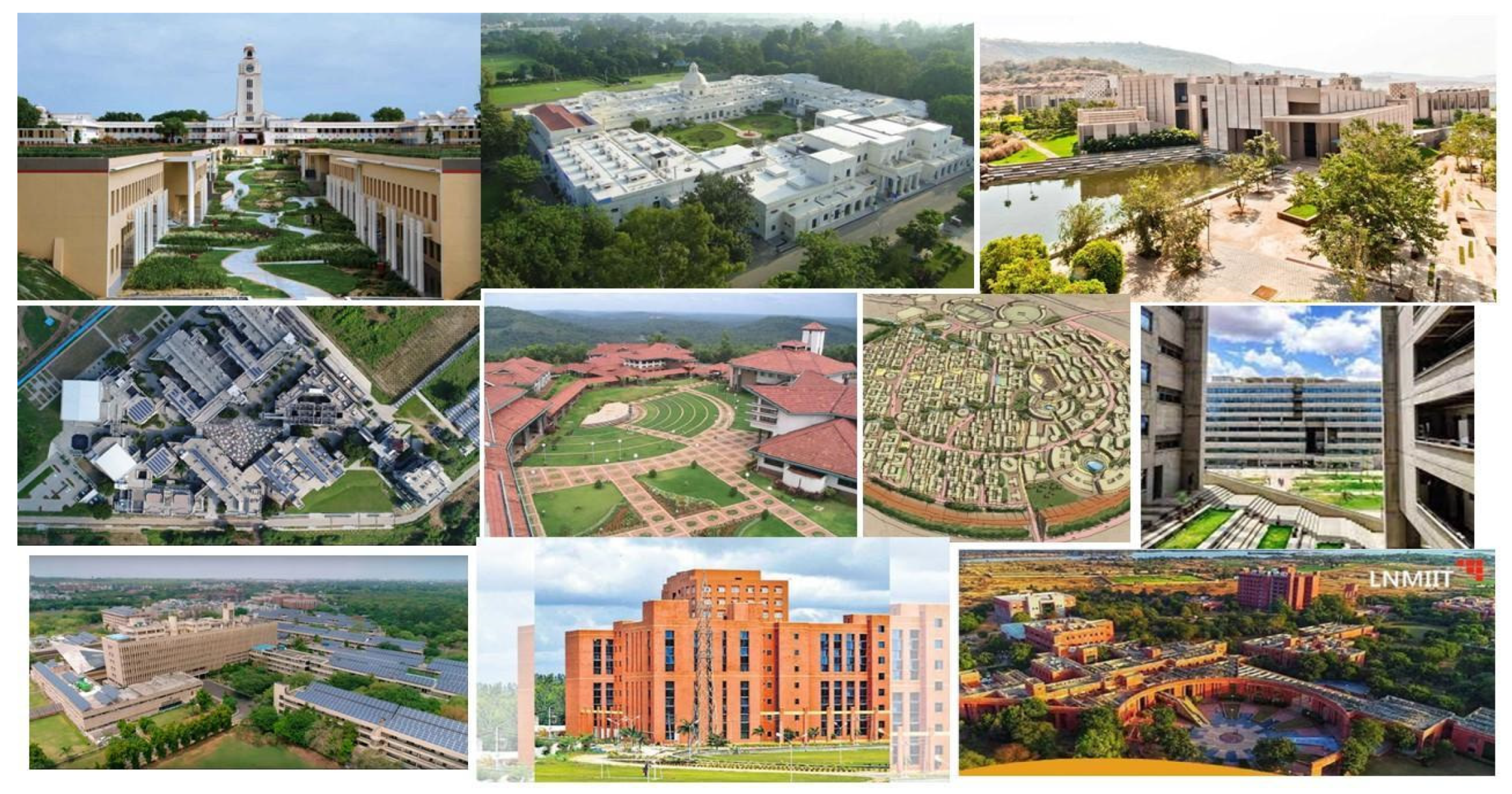
- Scenario “BAU”: The Campus will expand its infrastructural capacity to accommodate more students on-campus, hire a nominal number of faculty/staff to meet the needs, build more energy-consuming labs, and procure and add more appliances for business continuity and productivity;
- Scenario “Top-Down”: The Campus will expand its infrastructural capacity to accommodate more students on-campus, hire more faculty to meet the needs, build more energy-consuming labs, and procure and add more appliances for business continuity and productivity—all the above would be performed to meet regulations set by the governing council for education such as accreditation bodies to transition to net zero;
- Scenario “Bottom-Up”: The campus will expand its infrastructural capacity to accommodate more students on-campus, hire more faculty to meet the needs strategically (e.g., computer science faculty with experience in climate change, behavioral change, and sustainability), build energy-aware learning environments, and procure appliances with a long-term energy footprint in-mind—all the above would be performed not to meet the regulations but through behavioral interventions for the campus community consisting of the faculty, staff and students, and greater awareness for the administration to reduce energy consumption, strategic industry partnerships to learn the best practices and focus on long-term stewardship.
4. Discussion
5. Conclusions and Future Work
Author Contributions
Funding
Institutional Review Board Statement
Informed Consent Statement
Data Availability Statement
Acknowledgments
Conflicts of Interest
References
- MNRE-CEEW. Accelerating Citizen-Centric Energy Transition: The India Story. 2021. Available online: https://mnre.gov.in/img/documents/uploads/file_f-1624273899989.pdf (accessed on 5 June 2023).
- Rajasekar, U.; Shankar, V.; Singh, R.; Gupta, A.D.; Mandal, A.; Dutta, M.; Gandhi, P.; Bhaisare, M.; Kumar, E.U.; Shravani, T.; et al. ClimateSmart Cities Assessment Framework 2.0 Cities Readiness Report; Ministry of Housing and Urban Affairs: New Delhi, India, 2021.
- IGBC Net-Zero Energy Building. Available online: https://igbc.in/igbc/redirectHtml.htm?redVal=showNetZeroEnergyBuildingsNosignin (accessed on 5 June 2023).
- Madathil, D.; Nair, M.G.; Jamasb, T.; Thakur, T. Consumer-focused solar-grid net zero energy buildings: A multi-objective weighted sum optimization and application for India. Sustain. Prod. Consum. 2021, 27, 2101–2111. [Google Scholar] [CrossRef]
- Panicker, K.; Anand, P.; George, A. Typology-wise residential energy benchmarking and net ZEB potential: A case study of residential complexes inside IIT Kharagpur, India. In Proceedings of the 9th ACM International Conference on Systems for Energy-Efficient Buildings, Cities, and Transportation, Boston, MA, USA, 9–10 November 2022; pp. 426–432. [Google Scholar]
- Shunya Labelling for NZEBs and NPEBs. Available online: https://beeindia.gov.in/en/programmesenergy-efficiency-in-buildings/shunya-labeling (accessed on 5 June 2023).
- Painuly, J.P. Financing energy efficiency: Lessons from experiences in India and China. Int. J. Energy Sect. Manag. 2009, 3, 293–307. [Google Scholar] [CrossRef]
- Mathur, A. Public costs and private benefits: The governance of energy efficiency in India. Build. Res. Inf. 2019, 47, 123–126. [Google Scholar] [CrossRef]
- Shukla, S.; Zia, H. Energy efficiency in India: Policies and their impacts. Energy Sources Part B Econ. Plan. Policy 2016, 11, 982–989. [Google Scholar] [CrossRef]
- Chaturvedi, V. A vision for a net-zero energy system for India. Energy Clim. Chang. 2021, 2, 100056. [Google Scholar] [CrossRef]
- Bano, F.; Sehgal, V. Evaluation of energy-efficient design strategies: Comparison of the thermal performance of energy-efficient office buildings in composite climate, India. Sol. Energy 2018, 176, 506–519. [Google Scholar] [CrossRef]
- Ghofrani, A.; Zaidan, E.; Abulibdeh, A. Simulation and impact analysis of behavioral and socioeconomic dimensions of energy consumption. Energy 2022, 240, 122502. [Google Scholar] [CrossRef]
- Stern, P.C.; Janda, K.B.; Brown, M.A.; Steg, L.; Vine, E.L.; Lutzenhiser, L. Opportunities and insights for reducing fossil fuel consumption by households and organizations. Nat. Energy 2016, 1, 16043. [Google Scholar]
- Hong, T.; Yan, D.; D’Oca, S.; Chen, C.F. Ten questions concerning occupant behavior in buildings: The big picture. Build. Environ. 2017, 114, 518–530. [Google Scholar] [CrossRef]
- Wang, H.; Dong, Z.; Xu, Y.; Ge, C. Eco-compensation for watershed services in China. Water Int. 2016, 41, 271–289. [Google Scholar] [CrossRef]
- Stephenson, J.; Barton, B.; Carrington, G.; Gnoth, D.; Lawson, R.; Thorsnes, P. Energy cultures: A framework for understanding energy behaviours. Energy Policy 2010, 38, 6120–6129. [Google Scholar] [CrossRef]
- Hansen, A.R. Heating homes: Understanding the impact of prices. Energy Policy 2018, 121, 138–151. [Google Scholar] [CrossRef]
- Dubois, G.; Sovacool, B.; Aall, C.; Nilsson, M.; Barbier, C.; Herrmann, A.; Bruyère, S.; Andersson, C.; Skold, B.; Nadaud, F.; et al. It starts at home? Climate policies targeting household consumption and behavioral decisions are key to low-carbon futures. Energy Res. Soc. Sci. 2019, 52, 144–158. [Google Scholar] [CrossRef]
- Jackson, T. Motivating sustainable consumption: A review of evidence on consumer behaviour and behavioural change. In A Report to the Sustainable Development Research Network; Policy Studies Institute: London, UK, 2005. [Google Scholar]
- International Energy Agency. World Energy Outlook 2022. Available online: https://www.iea.org/reports/world-energy-outlook-2022 (accessed on 23 August 2023).
- SDSN, Climateworks Centre, and Monash University 2022. Net Zero on Campus. New York: Sustainable Development Solutions Network (SDSN), Climateworks Centre, and Monash University (Monash). Available online: https://irp.cdn-website.com/be6d1d56/files/uploaded/Net-Zero-on-Campus_interactive.pdf (accessed on 23 August 2023).
- Hossaini Fard, N. Towards Net Zero Buildings Assessment Framework: A Natural Capital Approach. Ph.D. Thesis, University of British Columbia, Vancouver, BC, Canada, 2018. [Google Scholar]
- Hossaini, N.; Hewage, K.; Sadiq, R. Spatial life cycle sustainability assessment: A conceptual framework for net-zero buildings. Clean Technol. Environ. Policy 2015, 17, 2243–2253. [Google Scholar] [CrossRef]
- Shen, K.; Ding, L.; Wang, C.C. Development of a Framework to Support Whole-Life-Cycle Net-Zero-Carbon Buildings through Integration of Building Information Modelling and Digital Twins. Buildings 2022, 12, 1747. [Google Scholar] [CrossRef]
- Becchio, C.; Bottero, M.C.; Corgnati, S.P.; Dell’Anna, F. Decision making for sustainable urban energy planning: An integrated evaluation framework of alternative solutions for a NZED (Net Zero-Energy District) in Turin. Land Use Policy 2018, 78, 803–817. [Google Scholar] [CrossRef]
- Rethnam, O.R.; Thomas, A. A Community Building Energy Modelling–Life Cycle Cost Analysis framework to design and operate net zero energy communities. Sustain. Prod. Consum. 2023, 39, 382–398. [Google Scholar] [CrossRef]
- Hyde, R.; Rajapaksha, U.; Rajapaksha, I.; Riain, M.O.; Silva, F. A design framework for achieving net zero energy commercial buildings. In Proceedings of the 46th Annual Conference of the Architectural Science Association (ASA/ANZAScA), Gold Coast, QL, Australia, 14–16 November 2012; pp. 14–16. [Google Scholar]
- Bekker, M.; Cummin, T.; Osborne, K.; Bruining, A.; Leland, L. Encouraging electricity savings in a university residential hall through a combination of feedback, visual prompts and incentives. J. Appl. Behav. Anal. 2010, 43, 327–331. [Google Scholar] [CrossRef]
- Viebahn, P. An environmental management model for universities: From environmental guidelines to staff involvement. J. Clean. Prod. 2002, 10, 3–12. [Google Scholar] [CrossRef]
- Jafary, M.; Wright, M.; Shephard, L.; Gomez, J.; Nair, R.U. Understanding Campus Energy Consumption–People, Buildings and Technology. In Proceedings of the 2016 IEEE Green Technologies Conference (GreenTech), Kansas City, MO, USA, 6–8 April 2016; IEEE: Piscataway, NJ, USA, 2016; pp. 68–72. [Google Scholar]
- Prafitasiwi, A.G.; Rohman, M.A.; Ongkowijoyo, C.S. The occupant’s awareness to achieve energy efficiency in campus building. Results Eng. 2022, 14, 100397. [Google Scholar] [CrossRef]
- Alomari, M.M.; EL-Kanj, H.; Topal, A.; Alshdaifat, N.I. Energy conservation behavior of university occupants in Kuwait: A multigroup analysis. Sustain. Energy Technol. Assess. 2022, 52, 102198. [Google Scholar] [CrossRef]
- Wagner, C.; Gibberd, J. Reducing students’ ecological footprints through self-developed interventions. S. Afr. J. Psychol. 2022, 52, 533–544. [Google Scholar] [CrossRef]
- János, L.M. Students Energy Saving Behavior Case Study of University of Coimbra. Ph.D. Thesis, Universidade de Coimbra, Coimbra, Portugal, 2011. [Google Scholar]
- Mosher, H.R.; Marcie, D. The effects of information regarding sustainability issues and behavioral self-management instruction on college students’ energy conservation. Int. J. Sustain. High. Educ. 2014, 15, 359–370. [Google Scholar] [CrossRef]
- Carrico, A.R.; Manuel, R. Motivating energy conservation in the workplace: An evaluation of the use of group-level feedback and peer education. J. Environ. Psychol. 2011, 31, 1–13. [Google Scholar] [CrossRef]
- Devine-Wright, P. Energy citizenship: Psychological aspects of evolution in sustainable energy technologies. In Governing Technology for Sustainability; Routledge: London, UK, 2012; pp. 63–86. [Google Scholar]
- Dadi, S.; Sara, B.; Amer, A.; Anders, B.H.; Loui, A.; Allan, S.P. Energy supply modelling of a low-CO2 emitting energy system: Case study of a Danish municipality. Appl. Energy 2017, 195, 922–941. [Google Scholar]
- Simiscuka, A.A.; Markande, T.M.; Muntean, G.M. Real-virtual world device synchronization in a cloud-enabled social virtual reality IoT network. IEEE Access 2019, 7, 106588–106599. [Google Scholar] [CrossRef]
- Lin, B.; Huang, C. Nonlinear relationship between digitization and energy efficiency: Evidence from transnational panel data. Energy 2023, 276, 127601. [Google Scholar] [CrossRef]
- Indraganti, M. Behavioural adaptation and the use of environmental controls in summer for thermal comfort in apartments in India. Energy Build. 2010, 42, 1019–1025. [Google Scholar] [CrossRef]
- Mander, S.; Vishnupriya, V.; Lovreglio, R. Using 360-Degree Virtual Tours to Teach Construction Students. In Proceedings of the 45th AUBEA Conference Proceedings 2022: Global Challenges in a Disrupted World: Smart, Sustainable and Resilient Approaches in the Built Environment, Sydney, Australia, 23–25 November 2022. [Google Scholar]
- Kalluri, B.; Subramaniam, R. BiBo: A serious boardgame to accelerate urban innovation in global-south. In Proceedings of the BEHAVE2023 Conference, Maastricht, The Netherlands, 28–29 November 2023. [Google Scholar]
- Wu, X.; Liu, S.; Shukla, A. Serious games as an engaging medium on building energy consumption: A review of trends, categories and approaches. Sustainability 2020, 12, 8508. [Google Scholar] [CrossRef]
- Dhariwal, J.; Karkare, A.; Dhariwal, A.; Bhatia, E.; Bhatia, P.; John, J.J.; Mathew, C.; Kumar, P.; Other Team Shunya Members. Deliverable#7 for Solar Decathlon Europe 2014: H-Naught Project Manual. 2014. Available online: http://www.solardecathlon2014.fr/en/documentation (accessed on 30 November 2023).
- Krath, J.; Schürmann, L.; Von Korflesch, H.F. Revealing the theoretical basis of gamification: A systematic review and analysis of theory in research on gamification, serious games and game-based learning. Comput. Hum. Behav. 2021, 125, 106963. [Google Scholar] [CrossRef]
- Ambrose, A. Walking with Energy: Challenging energy invisibility and connecting citizens with energy futures through participatory research. Futures 2020, 117, 102528. [Google Scholar] [CrossRef]
- Lord, C.; Ellsworth-Krebs, K.; Holmes, T. ‘Telling tales’: Communicating UK energy research through fairy tale characters. Energy Res. Soc. Sci. 2023, 101, 103100. [Google Scholar] [CrossRef]
- Dyussembekova, N.; Temirgaliyeva, N.; Umyshev, D.; Shavdinova, M.; Schuett, R.; Bektalieva, D. Assessment of Energy Efficiency Measures’ Impact on Energy Performance in the Educational Building of Kazakh-German University in Almaty. Sustainability 2022, 14, 9813. [Google Scholar] [CrossRef]
- Virdis, M.R.; International Energy Agency. Energy to 2050: Scenarios for a Sustainable Future; OECD/IEA: Paris, France, 2003. [Google Scholar]
- SRM Institute of Science and Technology. U75 Workshop: SRMIST’s Path to Carbon Neutrality. 2023. Available online: https://www.srmist.edu.in/u75-workshop-srmists-path-to-carbon-neutrality/ (accessed on 5 June 2023).
- IIT Delhi. IIT Delhi Climate Action Plan. 2022. Available online: https://home.iitd.ac.in/uploads/Climate%20Action_%20IITD_2023.pdf (accessed on 5 June 2023).
- Maller, C.; Strengers, Y. The global migration of everyday life: Investigating the practice memories of Australian migrants. Geoforum 2013, 44, 243–252. [Google Scholar] [CrossRef]
- Palm, J.; Ambrose, A. Exploring energy citizenship in the urban heating system with the ‘Walking with Energy’ methodology. Energy Sustain. Soc. 2023, 13, 11. [Google Scholar] [CrossRef] [PubMed]
- Infosys. Pioneering Net Zero Buildings: The Infosys Journey. 2023. Available online: https://www.infosys.com/about/corporate-responsibility/documents/pioneering-net-zero-buildings.pdf (accessed on 23 August 2023).
- Vijayji, M.S. Ahimsa Vrat. 2019. Available online: https://medium.com/muni-speaks/ahimsa-vrat-cbcbc196598e (accessed on 5 June 2023).
- UTCI, UTCI Calculator. Available online: http://www.utci.org/utcineu/utcineu.php (accessed on 30 May 2023).
- Dhariwal, J.; Gangrade, S. Learnings from thermal comfort adaptation of Jain ascetics during heat waves. In Proceedings of the Energise India 2023 Conference, Goa, India, 31 October 31–4 November 2023. [Google Scholar]
- Shetty, S. IREDA Organizes interactive session on Energy literacy with “Solar Man of India”. 2023. Available online: https://solarquarter.com/2023/05/06/ireda-organizes-interactive-session-on-energy-literacy-with-solar-man-of-india/ (accessed on 5 June 2023).
- ECBC. Available online: https://beeindia.gov.in/en/energy-conservation-building-code-ecbc (accessed on 5 June 2023).
- Thondhlana, G.; Kua, H.W. Promoting household energy conservation in low-income households through tailored interventions in Grahamstown, South Africa. J. Clean. Prod. 2016, 131, 327–340. [Google Scholar] [CrossRef]
- He, H.Z.; Kua, H.W. Lessons for integrated household energy conservation policy from Singapore’s southwest Eco-living Program. Energy Policy 2013, 55, 105–116. [Google Scholar] [CrossRef]
- Wu, W.; Zhang, X.; Yang, Z.; Wall, G.; Wang, F. Creating a low carbon tourism community by public cognition, intention and behaviour change analysisa case study of a heritage site (Tianshan Tianchi, China). Open Geosci. 2017, 9, 197–210. [Google Scholar] [CrossRef][Green Version]
- Jain, M. Estimates of energy savings from energy efficiency improvements in India using Index Decomposition Analysis. Energy Sustain. Dev. 2023, 74, 285–296. [Google Scholar] [CrossRef]

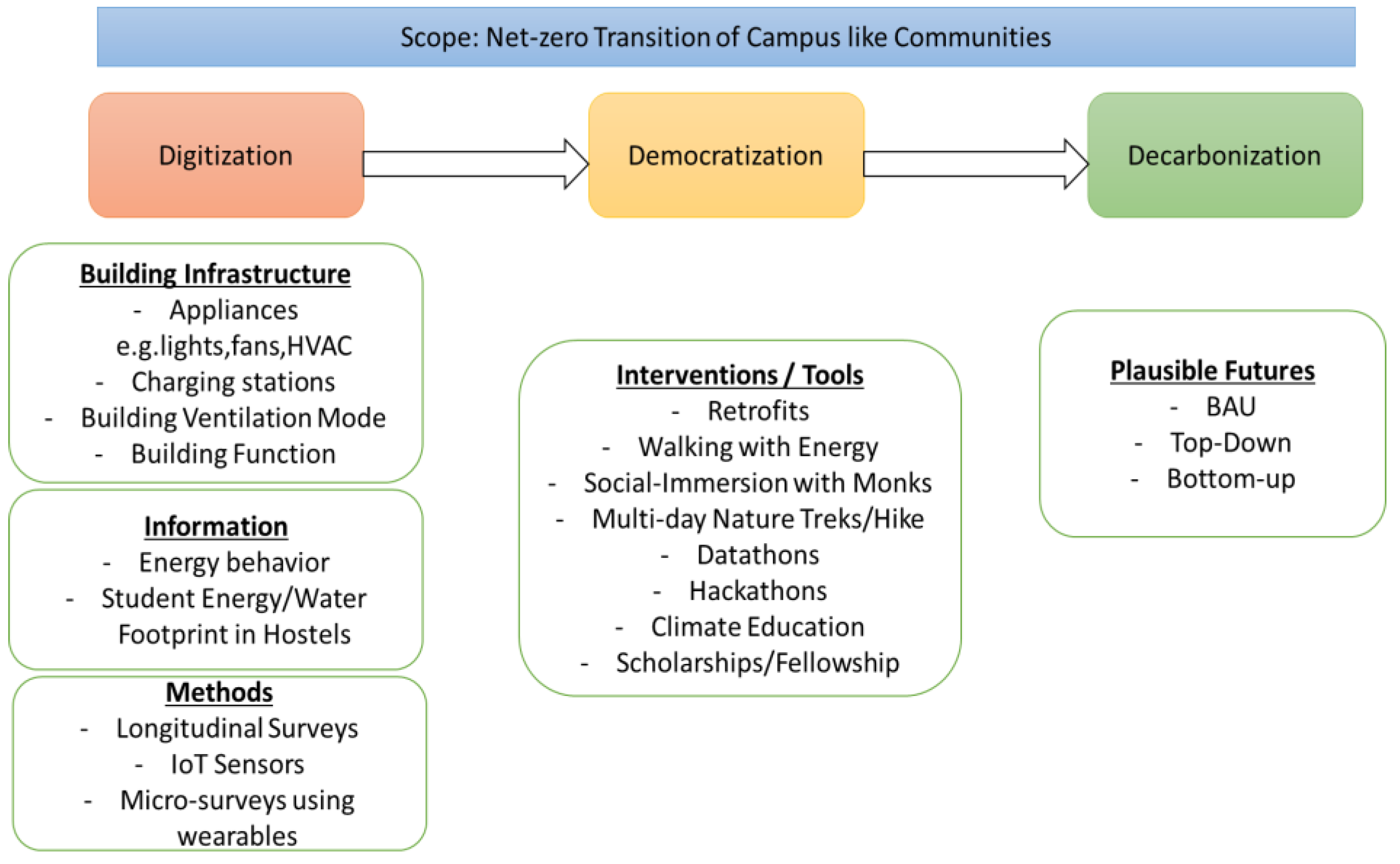

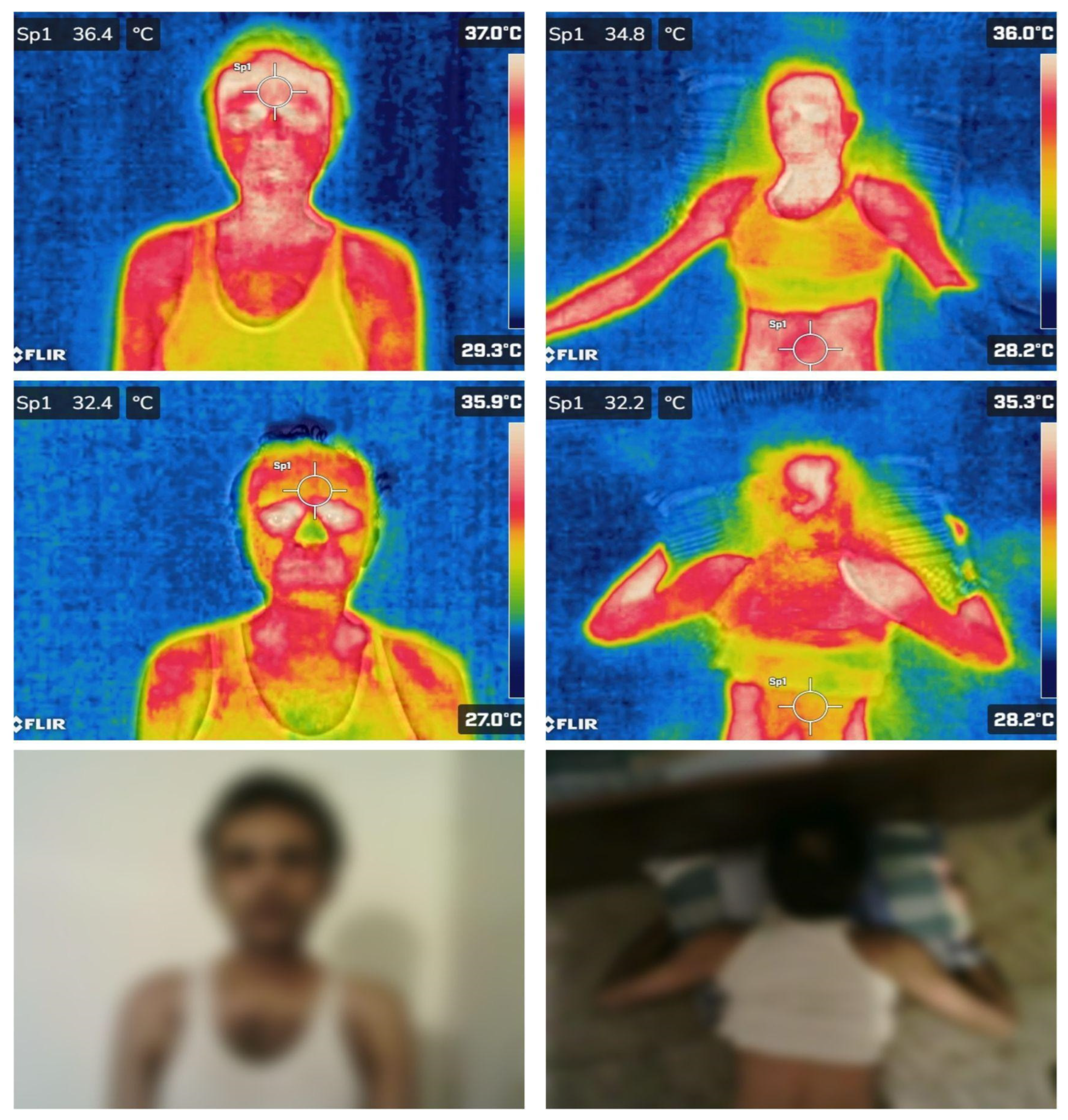
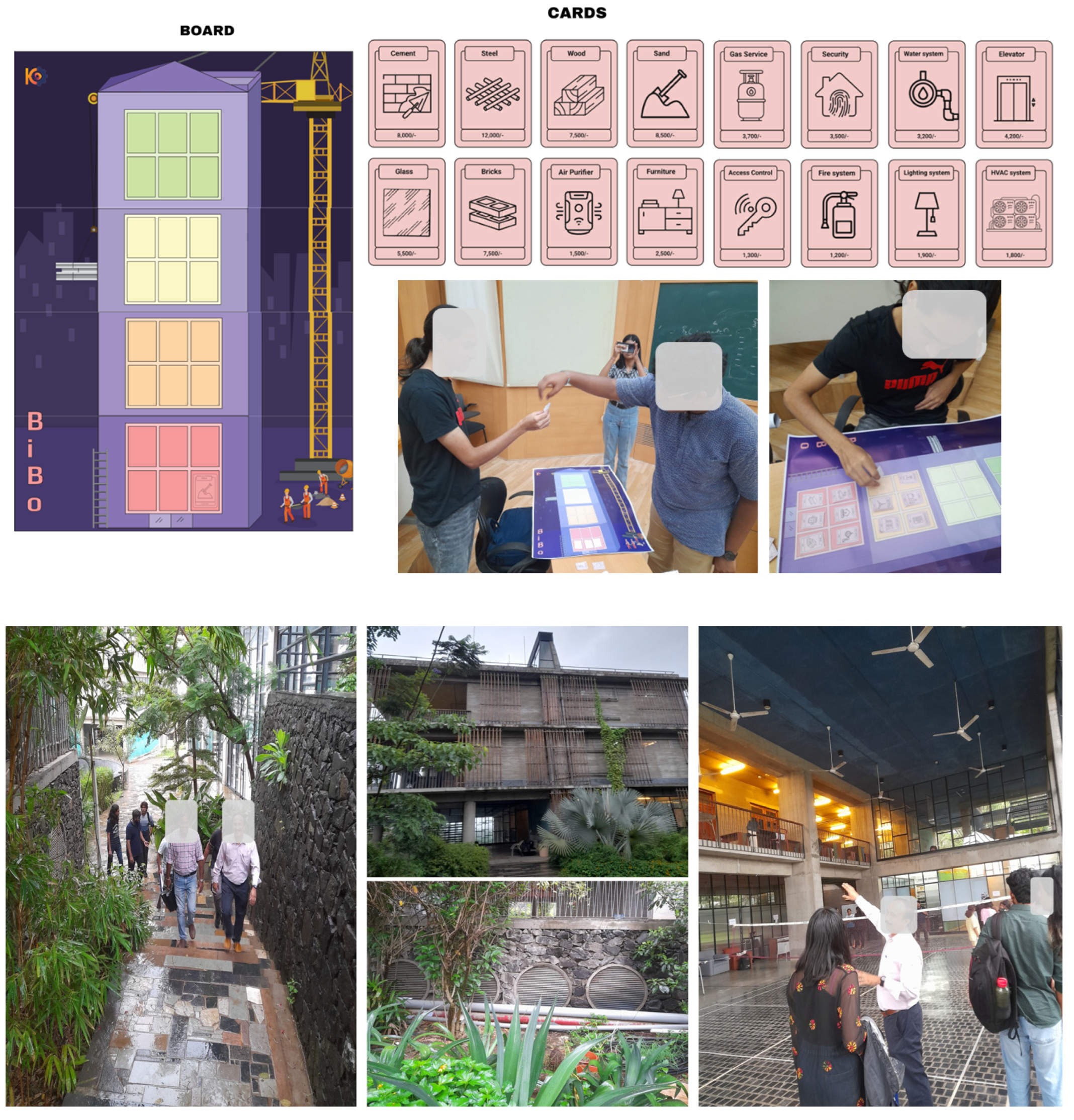
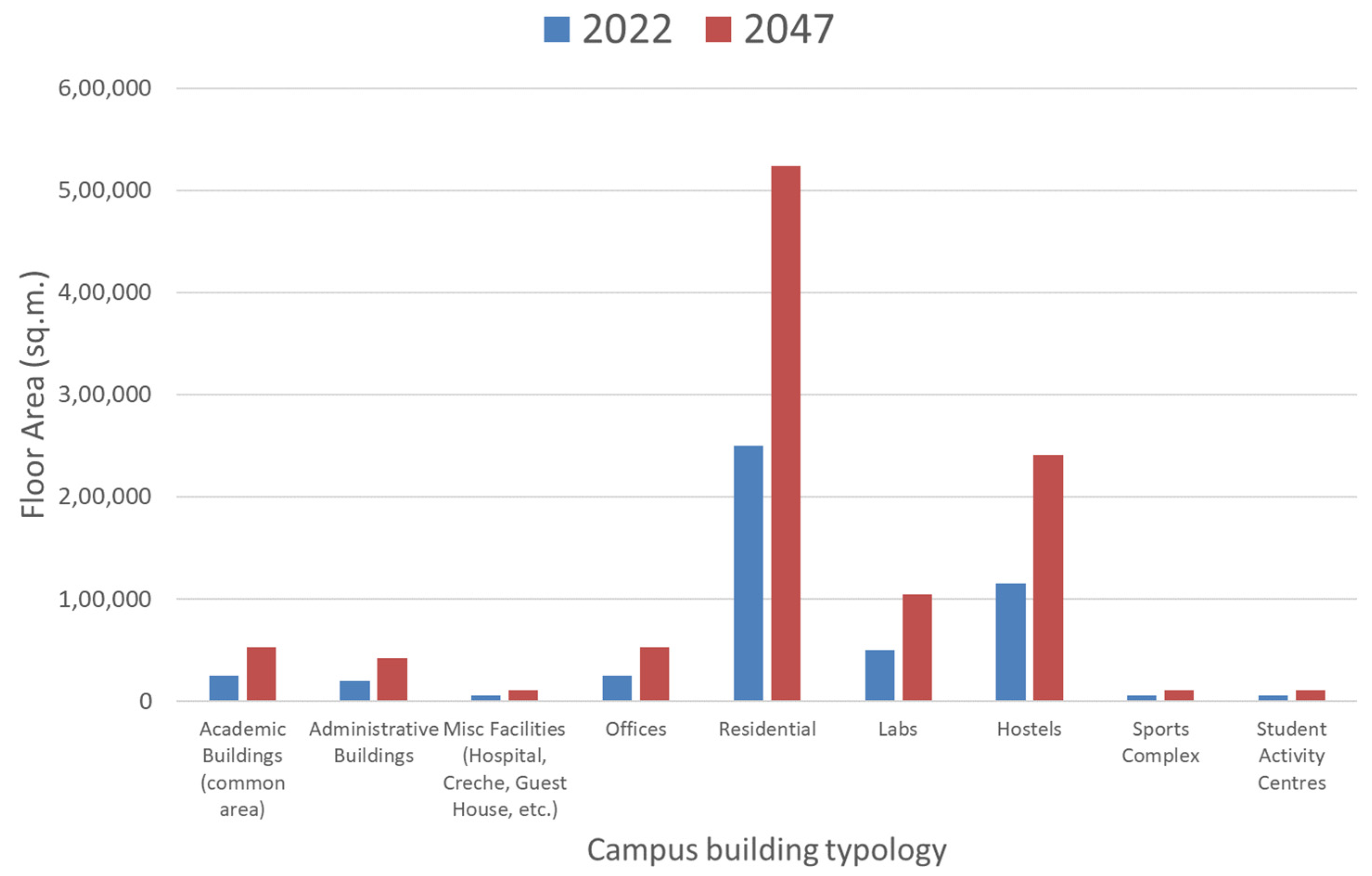

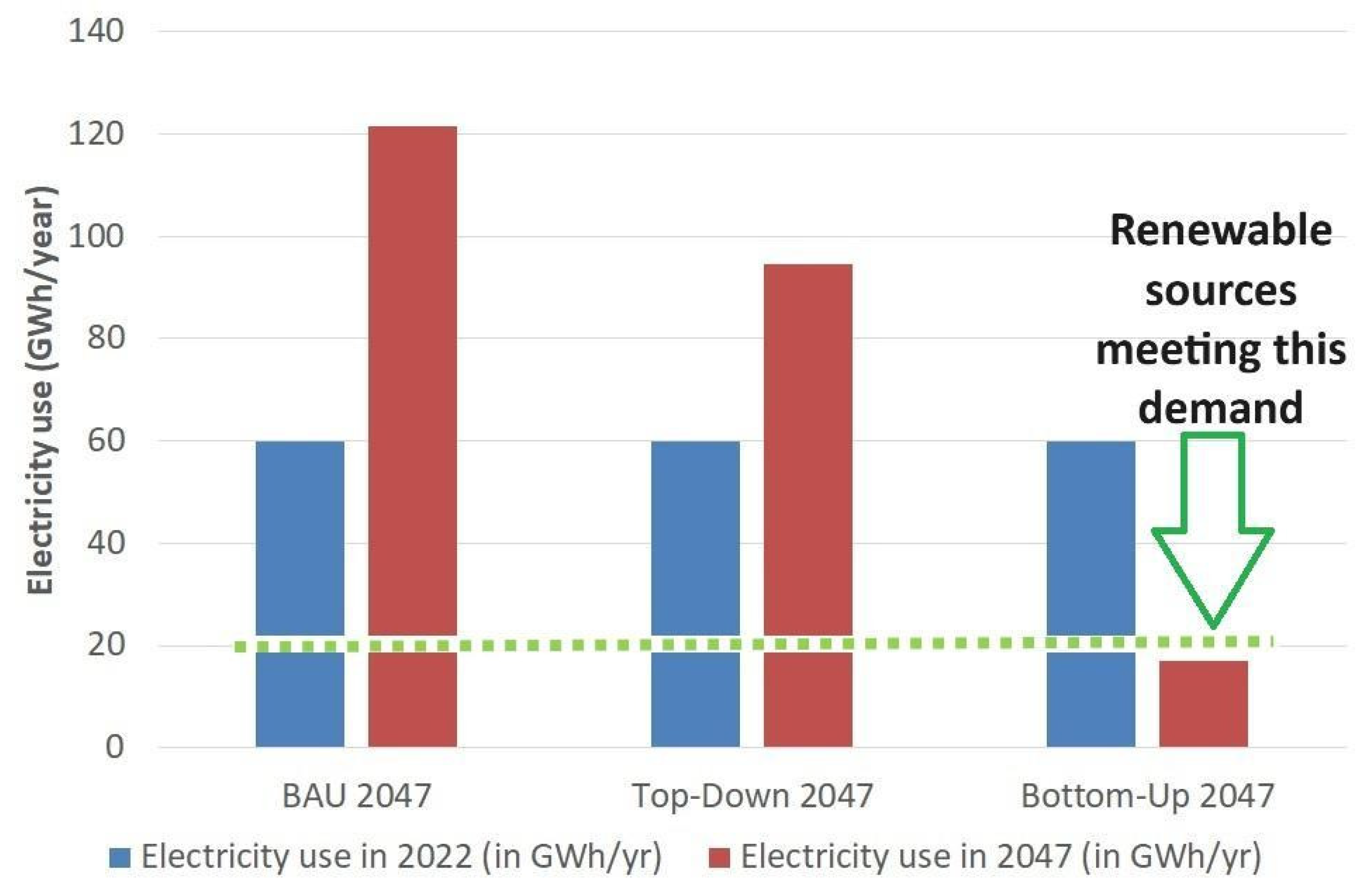
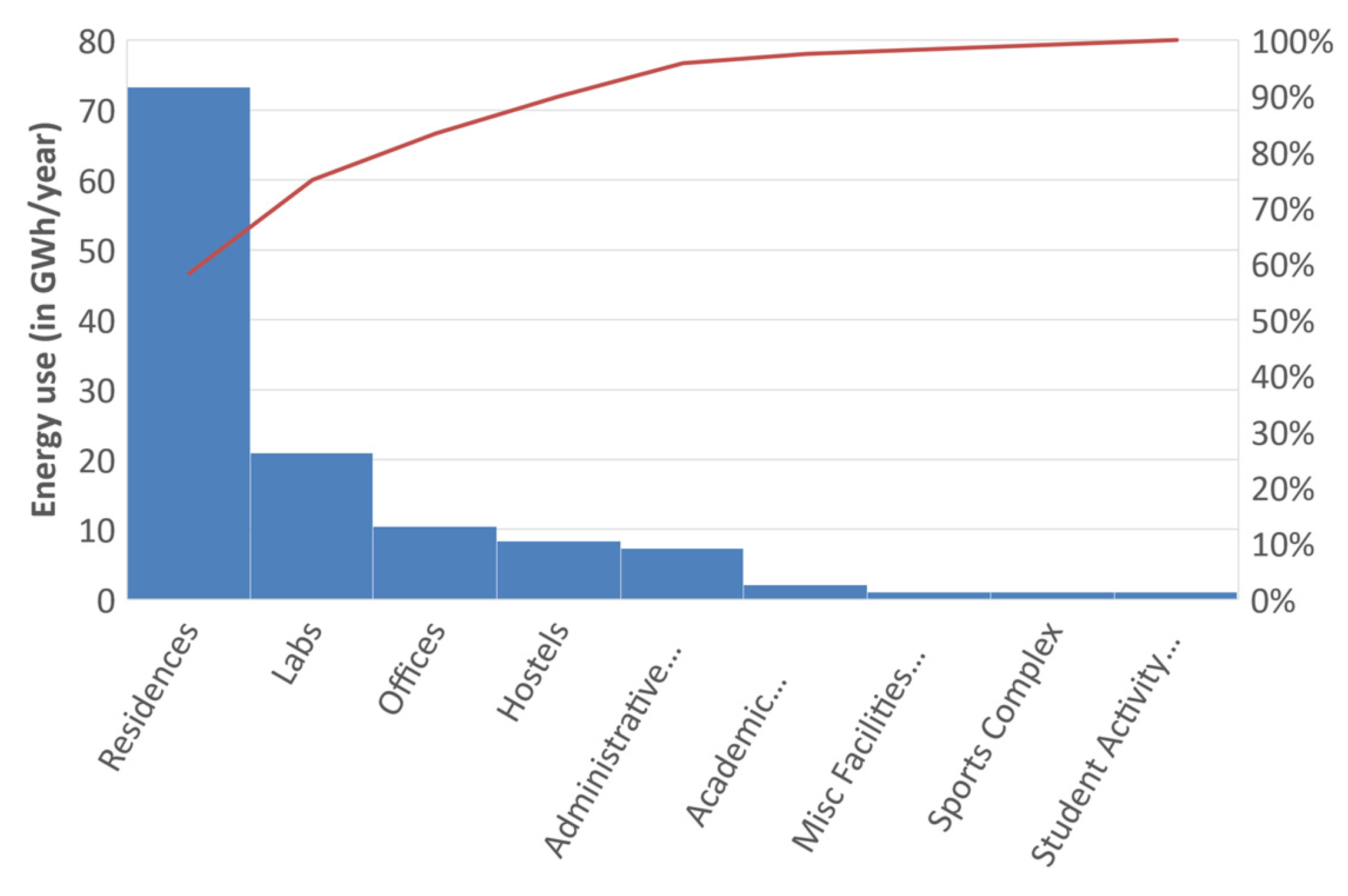
| Experiential Activities/Programs | Country | Context/Game Objective | References |
|---|---|---|---|
| Walking with Energy’—A guided energy walk | Sweden and UK | Energy Citizenship | [47] |
| Integrated Child Development Services, Kaun Hai Master? Kya Hai Plan?, City for All? | India | Tactical Urbanism | https://www.socialdesigncollab.org/open-source (accessed on 23 August 2023) |
| Telling Tales | UK | Storytelling to tackle the “wicked problems” of climate change | [48] |
| Shaping Future, Polity, Unpack Play, Curriculum for 74th Amendment | India | To design better policies using games and simulations. | https://fieldsofview.in/projects/ (accessed on 23 August 2023) |
| Climate Hackathon | Norway with Microsoft | To develop software solutions for energy consumption problems. | https://climatehackathon.devpost.com/ (accessed on 23 August 2023) |
| The Climate Change Emergency Hackathon | UK | To explore the use of data to tackle the climate emergency. | https://www.ofgem.gov.uk/publications/climate-change-emergency-hackathon (accessed on 23 August 2023) |
| Games Title | Building Type | Game Objective |
|---|---|---|
| Power Agent | Real House | Change in human behavior |
| Power Explorer | Real House | |
| EnerCities | Virtual Cities | |
| EnergyLife | Real House | |
| Energy Battle | Dormitory | |
| Super Delivery | Virtual Cities | |
| Ghost Hunter | Real House | |
| eViz | Virtual Apartment | |
| Do It In The Dark | Dormitory | |
| Energy Chicken | Real House | |
| Residence Energy Saving (RES) battle | Virtual house/Virtual Commercial | |
| Power House | Virtual House | |
| Social Power | Virtual House | |
| Greenplay | Real House | |
| Ringorang | Real House | |
| Energy Cat | Real House | |
| Energy Piggy Bank | N/A | |
| Smarter Households | Real House | |
| Serena Games | Virtual House | Design and improvisation of the game |
| Greenify | N/A | |
| EcoIsland | N/A |
| Item Description | Value |
|---|---|
| Campus area (in sq.m.) | 1,200,000 |
| Forest area on campus (in m2) | 200,000 |
| Number of students | 10,000 |
| Number of students residing on campus | 7000 |
| Number of faculty and staff | 1000 |
| Number of faculty and staff residing on campus with their families | 3000 |
| Total campus residents | 10,000 |
| Electricity consumption for the year 2022 (in GWh) | 60 |
| Electricity supply from Solar PV + Hydropower (in GWh in 2022) | 20 |
| Built-up area (in sq.m.) | 500,000 |
| Building Typology | EPI (kWh/sq.m.-year) |
|---|---|
| Academic Buildings (common area) | 40 |
| Administrative Buildings | 175 |
| Misc Facilities (Hospital, Creche, Guest House, etc.) | 100 |
| Faculty Offices | 200 |
| Residences | 140 |
| Labs | 200 |
| Hostels | 35 |
| Sports Complex | 100 |
| Student Activity Centers | 100 |
| Influencing Factors | High | Medium | Low |
|---|---|---|---|
| Energy Use Factor for Administration | 1 | 0.7 | 0.4 |
| Energy Use Factor for Students | 1 | 0.8 | 0.2 |
| Energy Use Factor for Faculty and Academic Staff | 1 | 0.6 | 0.3 |
| Hours of Operation | 1 | 0.8 | 0.6 |
Disclaimer/Publisher’s Note: The statements, opinions and data contained in all publications are solely those of the individual author(s) and contributor(s) and not of MDPI and/or the editor(s). MDPI and/or the editor(s) disclaim responsibility for any injury to people or property resulting from any ideas, methods, instructions or products referred to in the content. |
© 2023 by the authors. Licensee MDPI, Basel, Switzerland. This article is an open access article distributed under the terms and conditions of the Creative Commons Attribution (CC BY) license (https://creativecommons.org/licenses/by/4.0/).
Share and Cite
Kalluri, B.; Vishnupriya, V.; Arjunan, P.; Dhariwal, J. Net-Zero Energy Campuses in India: Blending Education and Governance for Sustainable and Just Transition. Sustainability 2024, 16, 87. https://doi.org/10.3390/su16010087
Kalluri B, Vishnupriya V, Arjunan P, Dhariwal J. Net-Zero Energy Campuses in India: Blending Education and Governance for Sustainable and Just Transition. Sustainability. 2024; 16(1):87. https://doi.org/10.3390/su16010087
Chicago/Turabian StyleKalluri, Balaji, Vishnupriya Vishnupriya, Pandarasamy Arjunan, and Jay Dhariwal. 2024. "Net-Zero Energy Campuses in India: Blending Education and Governance for Sustainable and Just Transition" Sustainability 16, no. 1: 87. https://doi.org/10.3390/su16010087
APA StyleKalluri, B., Vishnupriya, V., Arjunan, P., & Dhariwal, J. (2024). Net-Zero Energy Campuses in India: Blending Education and Governance for Sustainable and Just Transition. Sustainability, 16(1), 87. https://doi.org/10.3390/su16010087









